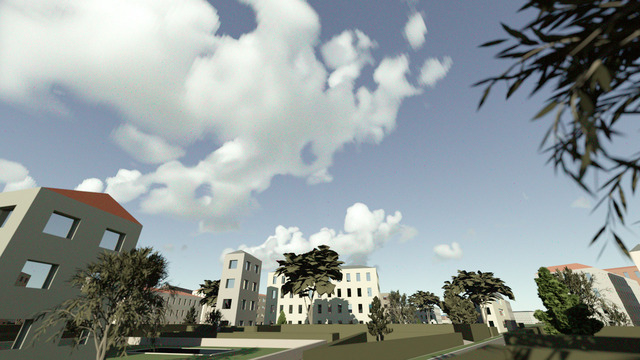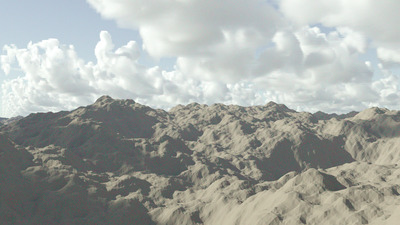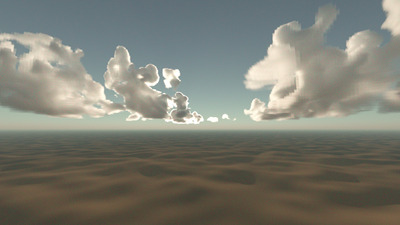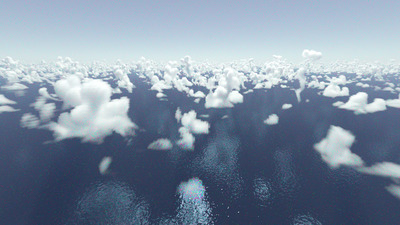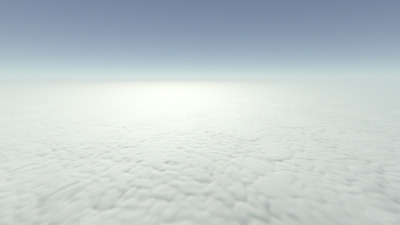htrdr: Atmosphere Starter Pack
The htrdr: Atmosphere Starter Pack contains input data to perform
renderings with
htrdr-atmosphere.
It also provides shell scripts that run predefined htrdr-atmosphere commands.
These scripts are examples and good starting points for learning how to run
htrdr-atmosphere; users are encouraged to modify and extend them.
The image of the city scene rendered with
htrdr-atmosphere. The thin lens camera used in this rendering focuses on background elements; the foreground vegetation is out of focus.
Downloads
| Version | Archive |
|---|---|
| 0.8.0 | [tarball] [pgp] |
Below are some of the NetCDF files used to generate the cloud data distributed with the Starter-Pack. In the Starter-Pack, they have been converted to htcp format using the les2htcp tool, which was specially developed to transform this data into the cloud file format required by htrdr-atmosphere.
These NetCDF files illustrate what a user's data might look like, produced by a specific toolchain, saved in a community file format, and finally converted by an intermediate tool (in this case les2htcp) into the input file format for htrdr-atmosphere.
For example, the spatial unit of DZVAR clouds is the kilometer (this can
be verified using the NetCDF tool ncdump).
So, to convert its NetCDF file to htcp format, simply enter the
following les2htcp command:
les2htcp -m 1000 \
-i DZVAR.1.ARMCU.008.diaKCL.nc \
-o DZVAR.1.ARMCU.008.diaKCL.htcp
These files serve to illustrate htrdr's agnosticism to external tool chains through file formats in which the user transforms their input data to run htrdr. These formats define not only the input protocol for htrdr-atmosphere, but also the physics it simulates: calculations are only possible if the data describing this physics exists.
Quick start
Assuming htrdr-atmosphere is properly installed and registered on your
current shell, just run the desired script. For example, to render the city
scene:
./city.sh
When invoking the script, htrdr-atmosphere is executed according to the data
and parameters defined in the city.sh file. After calculation, the resulting
image city_1280x720x256.txt is stored as htrdr-image file format. One can
then use the program
htpp to
convert it into a normal PPM file which can then be displayed with a regular
Image viewer.
htpp -i exposure=0.2 -o city.ppm city_1280x720x256.txt
Content
Atmospheric profile
The ecrad_opt_prop.txt file defines the gas optical properties provided for
the pressure and temperature atmospheric vertical profile. These data were
generated with the
ECRAD
software and are saved according to the
htgop
file format.
Clouds
The files contained in the clouds subdirectory contains
htcp files
defining the liquid water content in suspension within clouds. These fields are
generated from idealized Large Eddy Simulations computed by the French non
hydrostatic research model, MesoNH (Lafore et al.
1998, Lac et
al. 2018), with flat surfaces
and prescribed large-scale forcings. Available files are:
DZVAR.1.ARMCU.008.diaKCL.htcp: a continental cumulus case initialized from a composite of observed thermodynamic profiles measured on the ARM SGP site, following Brown et al. (2002). The provided field corresponds to the 8th hour of simulation (13h30 local time), in the middle of the diurnal cycle. The boundary layer is well-developed with cloud base height around 1km and cloud top around 2km, and a total cloud cover of around 25% of the 6.4km x 6.4km domain (horizontal resolution is 25m).L12km.1.BOMEX.005.htcp: an oceanic, trade wind cumulus case initialized from observed thermodynamic profiles acquired during the BOMEX campaign in the Barbados. The model set-up is as in Siebesma et al. (2003) but with a 12.8km x 12.8km domain and resolution 25m. The cloud layer is between 500m and 1.5km heights and covers around 14% of the domain.L25.1.FIRE.012.htcp: a marine stratocumulus case initialized from observed thermodynamic profiles acquired during the FIRE campaign off the coast of southern California. The model set-up is as in Duynkerke et al. (2004) with a 25km x 25km domain, 100m horizontal and 10m vertical resolutions. The field corresponds to the 12th hour of simulation (12h local time) typical of a decoupled boundary layer, with the overcast stratocumulus layer between 300 and 600m.
Images of the DZVAR, DZVAR2, L12km_BOMEX and L25_Fire scenes rendered with "htrdr-atmosphere".
Water droplets properties
The Mie_LUT_Cloud-2-10-0.010.nc file stores the spectro-angular tabulation of
water droplets optical properties computed using the Mishchenko et al.
(2002) implementation of the
Lorenz-Mie solution for light scattering by homogeneous spherical particles The
monodisperse solution was integrated over a log-normal droplet size
distribution of effective radius 10 micrometers and effective variance 0.01
micrometers. This NetCDF file is formatted according to the
htmie file
format.
Geometries
The models subdirectory contains geometries saved in the
htrdr-obj
file format. Available geometries are:
models/city.obj: geometry of 19,517,682 triangles of a procedurally generated city using several materials.models/desert.obj: OBJ of 2,097,152 triangles representing a desert. The geometry starts from 0 and extends to 10 kilometers in both X and Y dimensions. The maximum dune height is 100 meters. The geometry is cylic and thus can be infinitly repeated along the X and Y dimension.models/mountain.obj: geometry of 8,388,608 triangles representing mountains. The OBJ lower bound is 0 while its upper bound is [10000, 10000, 700] which means that its size along the X and Y axis is 10 kilometers while the highest mountain peaks at 700 meters. Note that the geometry is carefully designed to be cyclic: it can be repeated along the X and Y axis without visual glitches.models/plane.obj: quad centered in 0 whose size along the X and Y dimension is 10 meters.models/sea_3m.obj: geometry of 8,388,608 triangles representing a sea starting from 0 and extending to 10 km along the X and Y axis. The maximum wave height is 3 meters. The geometry is cyclic, that means that it can be repeated along the X and Y dimensions.
Ground materials
The materials/legacy subdirectory regroups various
MruMtl
files representing materials whose spectral properties have been collected /
inferred from available public sources: handbooks, manufacturer web sites, and
public databases such as the USGS High Resolution Spectral
Library.
Various sources have most of the time been necessary in order to gather data
over the whole thermal infrared range.
The MruMtl files contained in the materials/slum subdirectory are generated
from the Spectral Library of impervious Urban Materials
(SLUM) developped by S. Kotthaus et
al.
Finally, a set of
htrdr-materials
are stored in the materials directory. Each file is a list materials required
by the ground geometries (city.mtls, desert.mtls, mountain.mtls,
plane.mtls, sea.mtls), or the whole set of materials contained in the
aforementionned sub-directories (legacy.mtls and slum.mtls files).
Shell scripts
The provided shell scripts runs a htrdr-atmosphere command without any frills
except command arguments that are described by variables for ease of reading.
This is to give examples to users and invite them to study and modify these
commands according to their needs.
Release notes
Version 0.8
The GNU Bash htrdr-run.sh, a script used to dynamically construct an
htrdr-atmosphere command line, is now replaced by a set of no-frills POSIX
shell scripts, each executing a predefined htrdr-atmosphere command.
Command-line arguments are defined using variables for ease of reading. In
addition to its extensive compatibility, this rewrite was done to simplify the
reading and study of scripts in order to encourage users to edit and extend
them.
Version 0.7
- Add the
city_thin_lensscene. It sets a rendering of the city scene with a thin lens camera. - Add the
L12km_BOMEX_desc_flux_swscene used to compute the downward shortwave flux under the BOMEX cloud field. - Add the
DZVAR_orthoscene. It defines an orthographic rendering of the DZVAR cloud field from the top of the atmosphere. - Add the support of the
sensor_typekeyword in the scene files. Available types are:perspective camera,orthographic cameraandflux map. - Remove the support of the
operfkeyword in the scene files. - Rename the
ht-run.shscript inhtrdr-run.sh.
Version 0.6.1
- Update the
ht-run.shscript to handle the command update introduced byhtrdr0.7.
Version 0.6
- Add the
desert.objandsea_3m.objgeometries and their associateddesert.mtlsandsea.mtlshtrdr-materials file. - Update the "ground" geometry of the
DZVAR2andL12km_BOMEXscenes: use the desert rather than a plane inDZVAR2and replace the mountains by a sea inL12km_BOMEX. - Make specular the
blue_waterlegacy material.
Version 0.5
- Add new materials generated from the Spectral Library of impervious Ubran Materials (SLUM).
- Define one htrdr-materials file for each ground geometry.
- Update the htrdr-materials files with respect to the fileformat
updates introduced by
htrdr0.6. - Update the
city.objfile. This new geometry fix the interface description, use detailed tree meshes and the new SLUM materials.
Version 0.4
- Add the
longwaveandshortwavescene variables that enable the longwave or shortwave spectral integration onto the defined wavelength range with respect to the Planck function for a given reference temperature. This reference temperature can be set through thereference_temperaturevariable. - Update the Mie lookup table: in the previous one, the effective mass was no correctly computed.
- When MPI is enabled, force the path of the output image to the
$HOME/.htrdrlocal directory of the first host listed in thempi_hostsscene variable. - remove the
long_waveskeyword: it is now replaced bylongwave.
Version 0.3
- Update the geometry files to make them compatible with
htrdr0.4. - Add the
city.objgeometry that stores a procedurally generated city. - Add the
long_wavesvariable to the scene description that enables infrared rendering and defines the range of long waves to take into account. - Add a list of legacy materials used by the ground geometries.
- Add the
materialsvariable to the scene description that defines the path toward the htrdr-materials file used by the scene. - Update the layout of the
.htrdrdirectory used whenhtrdris ran through MPI. This directory, created at the root directory of each host that shared the computation, saves the input data required by the rendering as well as temporary files. For input files, this directory now strictly follows the layout of the Starter-Pack. - Handle spaces in paths.
Version 0.2
- Update the files describing the scenes as well as the
ht-run.shscript according to the updates introduce byhtrdr0.3: remove thecache_gridsvariable and replace it by thecache_skyone that defines whether the sky data structures are cached or not.
Copyright notice
Copyright © 2018, 2020, 2021, 2023 |Méso|Star> (contact@meso-star.com)
Copyright © 2018 Centre National de la Recherche Scientifique
Copyright © 2018 Université Paul Sabatier
The MruMtl files contained in the materials/slum subdirectory are created
from the Spectral Library of impervious Urban
Materials, copyright © 2013 University of
Reading.
License
htrdr: Atmosphere Starter Pack is released under the GPLv3+ license: GNU GPL
version 3 or later. You can freely study, modify or extend it. You are also
welcome to redistribute it under certain conditions; refer to the
license for details.
